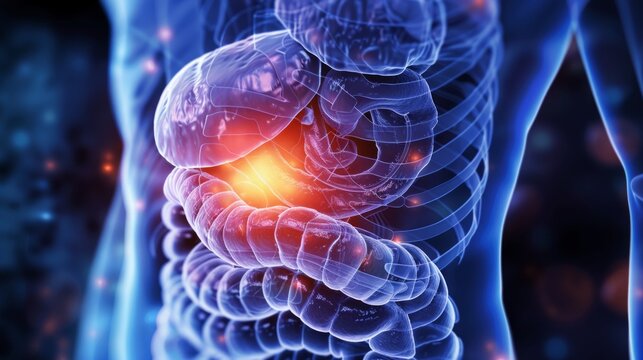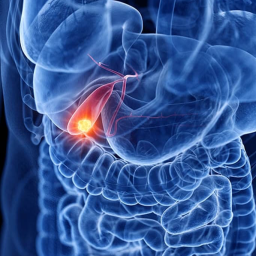
1. Introduction to Bile Duct Cancer
Bile duct cancer is classified based on its location:
- Intrahepatic Cholangiocarcinoma: Occurs in the bile ducts within the liver.
- Extrahepatic Cholangiocarcinoma: Develops in the bile ducts outside the liver, closer to the gallbladder and small intestine.
This cancer may grow slowly and initially not cause significant symptoms, making early diagnosis challenging. Over time, however, as the tumor obstructs bile flow or spreads, symptoms begin to manifest. Recognizing these symptoms can lead to earlier detection and better outcomes.
2. Jaundice: The Primary Symptom
One of the most common and noticeable symptoms of bile duct cancer is jaundice. Jaundice occurs when there is a buildup of bilirubin in the blood due to an obstruction in the bile ducts. This leads to yellowing of the skin and the whites of the eyes.
- Symptoms: Yellowing of the skin and eyes, dark urine, light-colored stools.
- Cause: When the bile duct is blocked by the tumor, bile, which contains bilirubin, cannot flow into the intestines and instead backs up into the bloodstream.
Jaundice is often the first sign of bile duct cancer, especially in extrahepatic cholangiocarcinoma, as the tumor may obstruct the common bile duct.
3. Abdominal Pain

Patients with bile duct cancer often experience pain in the upper abdomen, especially on the right side. This pain may be dull or sharp and can vary in intensity.
- Symptoms: Persistent pain in the upper abdomen, especially the right upper quadrant.
- Cause: The pain is generally due to the tumor growing within or near the liver or bile ducts. As the tumor enlarges, it can press on nearby organs and tissues, causing discomfort.
This pain may worsen after eating or when the patient is lying down.
4. Itchy Skin (Pruritus)
Pruritus, or itching of the skin, is another common symptom associated with bile duct cancer. This is usually caused by the accumulation of bile salts under the skin due to impaired bile flow.
- Symptoms: Persistent, generalized itching, particularly on the palms, soles of the feet, and back.
- Cause: As bile backs up due to duct obstruction, bile salts are deposited in the skin, causing irritation and itchiness.
Itchiness is often more severe at night and can significantly affect the patient’s quality of life.
5. Unexplained Weight Loss
Unintended weight loss is another symptom of bile duct cancer. This occurs because the cancer may interfere with the digestive process or cause a decrease in appetite.
- Symptoms: Gradual weight loss, loss of appetite.
- Cause: As bile flow is blocked, the digestion and absorption of fats are impaired, leading to nutritional deficiencies and unintentional weight loss.
Weight loss can be a sign of many different conditions, so it is important to consider it in combination with other symptoms for further evaluation.
6. Fever and Chills
Some individuals with bile duct cancer may develop intermittent fever and chills, especially if there is an infection due to the obstruction of the bile ducts.
- Symptoms: Low-grade fever, chills, sweating.
- Cause: The blockage of bile ducts can create a breeding ground for bacteria, leading to infections such as cholangitis (inflammation of the bile ducts), which causes fever and chills.
Cholangitis is a potentially life-threatening complication that requires immediate medical attention.
7. Nausea and Vomiting

Nausea and vomiting are common gastrointestinal symptoms that may occur as a result of bile duct cancer. The blockage of bile ducts affects digestion and may lead to a backup of digestive enzymes.
- Symptoms: Feeling nauseous, frequent vomiting.
- Cause: Tumor growth can obstruct bile flow and interfere with normal digestion. The bile is essential for the digestion of fats, and its obstruction can result in indigestion, nausea, and vomiting.
These symptoms can be aggravated by fatty foods, making eating uncomfortable for the patient.
8. Fatigue and Weakness
Fatigue and general weakness are common symptoms in cancer patients, including those with bile duct cancer. This can result from the body’s response to the tumor, anemia, or other systemic factors related to the disease.
- Symptoms: Chronic tiredness, feeling weak or sluggish.
- Cause: Tumor growth, loss of appetite, and anemia associated with bile duct cancer can contribute to overall fatigue. Additionally, the body may use significant energy in its efforts to fight the cancer, which further depletes energy reserves.
Fatigue is one of the most common complaints among cancer patients, and it can severely impact daily activities.
9. Changes in Stool Color and Consistency
Because bile is essential for the digestion and absorption of fats, bile duct cancer can lead to changes in stool color and consistency.
- Symptoms: Pale-colored stools that are greasy and float.
- Cause: The blockage of bile ducts causes a lack of bile in the intestines, leading to poorly digested fat and light-colored stools. This is often referred to as “acholic stools.”
These changes in stool appearance are often accompanied by dark urine due to the accumulation of bilirubin.
10. Swelling in the Abdomen
Swelling or bloating in the abdomen may also be present in some individuals with bile duct cancer. This can be a result of fluid accumulation, also known as ascites, which occurs when the liver is damaged or when the tumor causes obstruction.
- Symptoms: Abdominal bloating, visible swelling.
- Cause: Ascites can result from liver dysfunction caused by the tumor. Fluid buildup in the abdominal cavity may be due to increased pressure in the blood vessels, affecting the liver’s ability to function.
Ascites can cause discomfort and may require medical intervention to drain the accumulated fluid.
11. Early Detection and Diagnosis
While these symptoms can be indicative of bile duct cancer, they are not exclusive to this condition. Other liver diseases, gastrointestinal issues, and even other forms of cancer can present with similar signs. It is essential for individuals experiencing these symptoms to seek medical attention for proper evaluation.
- Diagnostic Methods: Diagnostic imaging (CT scan, MRI, ultrasound), biopsy, blood tests (including liver function tests), and endoscopic procedures like ERCP (Endoscopic Retrograde Cholangiopancreatography) may be used to diagnose bile duct cancer.
Early detection plays a crucial role in the treatment and management of bile duct cancer, as the prognosis is generally better when the cancer is caught in its early stages.
12. When to Seek Medical Attention
Individuals who experience any of the above symptoms, particularly jaundice, abdominal pain, or unexplained weight loss, should seek medical attention promptly. Timely intervention can improve the chances of diagnosing bile duct cancer early and initiating treatment strategies.
Bile duct cancer is a rare but serious condition that can significantly impact a patient’s health. The symptoms of this disease, including jaundice, abdominal pain, itchy skin, weight loss, and changes in stool color, should not be ignored. Early detection and medical intervention are key to improving the prognosis of patients with bile duct cancer.
If you or someone you know is experiencing any of these symptoms, it is important to consult a healthcare provider for a thorough evaluation and appropriate testing. As research into bile duct cancer continues to advance, greater awareness of its symptoms and risk factors can help in the fight against this challenging disease.


